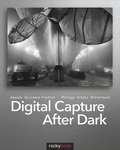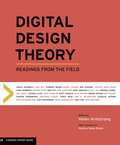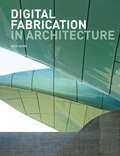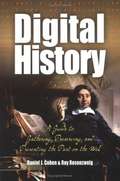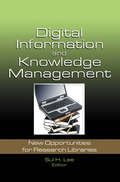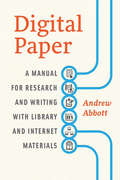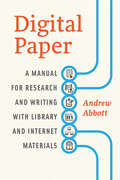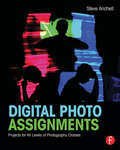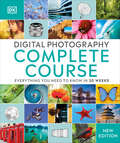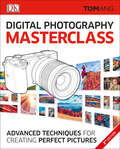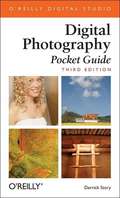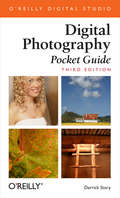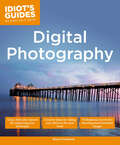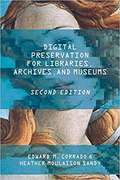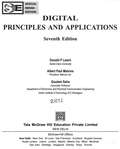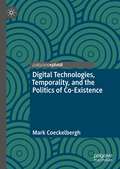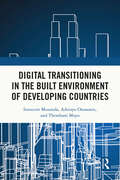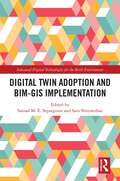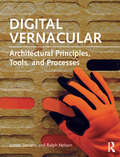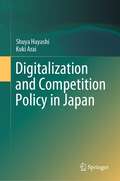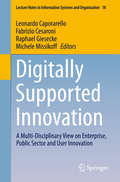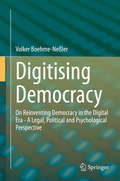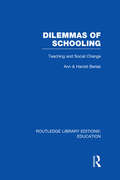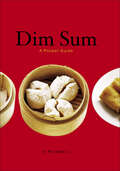- Table View
- List View
Digital Capture After Dark
by Amanda Quintenz-Fiedler Philipp Scholz RittermannThe pitfalls of photographing at night are many. Autofocus and built-in light meters generally fail at night. Long exposures tend to make noisy or blurry photographs. Cameras set to automatic generally trigger the built-in flash in low light conditions, which results in unsatisfying images. Lack of understanding and inappropriate techniques often ruin the dramatic potential of nighttime images. In Digital Capture After Dark you will learn to overcome these and other obstacles. You will go beyond the many "how-to's" of capturing digital images at night to the "why-to's" of long exposure photography; including the importance of how we think and see at night compared to during the day. Also discussed are hands-on image editing techniques that will help you prepare your images for output. Detailed descriptions cover color balancing, expanding dynamic range, controlling flare, dealing with noise, converting to black-and-white, toning, and much more.
Digital Design Theory: Readings from the Field
by Helen ArmstrongDigital Design Theory bridges the gap between the discourse of print design and interactive experience by examining the impact of computation on the field of design. As graphic design moves from the creation of closed, static objects to the development of open, interactive frameworks, designers seek to understand their own rapidly shifting profession. Helen Armstrong's carefully curated introduction to groundbreaking primary texts, from the 1960s to the present, provides the background necessary for an understanding of digital design vocabulary and thought.Accessible essays from designers and programmers are by influential figures such as Ladislav Sutnar, Bruno Munari, Wim Crouwel, Sol LeWitt, Muriel Cooper, Zuzana Licko, Rudy VanderLans, John Maeda, Paola Antonelli, Luna Maurer, and Keetra Dean Dixon. Their topics range from graphic design's fascination with programmatic design, to early strivings for an authentic digital aesthetic, to the move from object-based design and to experience-based design. Accompanying commentary assesses the relevance of each excerpt to the working and intellectual life of designers.
Digital Fabrication in Architecture
by Nick DunnWith the increasing sophistication of CAD and other design software, there is now a wide array of means for both designing and fabricating architecture and its components. The proliferation of advanced modelling software and hardware has enabled architects and students to conceive and create designs that would be very difficult to do using more traditional methods. The use of CAD technologies in the production of physical models, prototypes and individual elements is increasingly widespread through processes such as CAD/CAM, CNC milling and rapid prototyping. This translation of computer-generated data to physical artefact can also be reversed with devices such as a digitiser, which traces the contours of physical objects directly into the computer. This book focuses on the inspiring possibilities for architecture that can be explored with all the different technologies and techniques available for making complete designs or their components.
Digital Fabrication in Architecture
by Nick DunnWith the increasing sophistication of CAD and other design software, there is now a wide array of means for both designing and fabricating architecture and its components. The proliferation of advanced modelling software and hardware has enabled architects and students to conceive and create designs that would be very difficult to do using more traditional methods. The use of CAD technologies in the production of physical models, prototypes and individual elements is increasingly widespread through processes such as CAD/CAM, CNC milling and rapid prototyping. This translation of computer-generated data to physical artefact can also be reversed with devices such as a digitiser, which traces the contours of physical objects directly into the computer. This book focuses on the inspiring possibilities for architecture that can be explored with all the different technologies and techniques available for making complete designs or their components.
Digital History: A Guide to Gathering, Preserving, and Presenting the Past on the Web
by Roy Rosenzweig Daniel J. CohenCohen and Rosenzweig take their experiences with a project at George Mason U. titled "Echo: Exploring and Collecting History Online; Science, Technology, and Industry" and build them into an introduction to the Web for historians who want to produce or improve an online exhibit. They walk readers (teachers, students, activists, curators, amateur enthusiasts) through the process of planning a project, understanding the technologies involved, and responding to an intended audience effectively. Discussion includes coverage of copyright law and fair use for scholars, and of evolving Web techniques that enable interactivity. Annotation ©2005 Book News, Inc., Portland, OR (booknews.com)
Digital Information and Knowledge Management: New Opportunities for Research Libraries
by Sul H. LeeDigital Information and Knowledge Management examines how academic librarians can use knowledge management to provide an increasing amount of electronic information to an expanding user base. Several of the country’s leading library administrators analyze these vital issues from the perspectives of both information providers and library users, exploring the challenges of selecting and managing electronic information and resources, making the most of knowledge management, and improving digital access to their users. Electronic resources have given the library new roles to fill and created a demand for librarians skilled in the acquisition, retrieval, and dissemination of digital information. Libraries and librarians have met the challenges presented by digital resources and have moved from building collections of print materials into the growing field of knowledge management. Digital Information and Knowledge Management offers insights into how librarians are making that transition to enhance the resources and services they can offer library users. Topics examined in Digital Information and Knowledge Management include: cooperative collection development the balance of print and electronic resources the evolution of digital resources in libraries the concept of knowledge management changes in research libraries knowledge management in academic libraries factors that influence the selection of electronic resources disseminating information about scholarly collections the need for a standardized method of information presentation successful approaches to managing digital information the digitalization of collections and historical materials how to maintain the connections between academic disciplines and libraries and much more!Digital Information and Knowledge Management is an essential professional resource for senior- and mid-level library administrators, and for acquisitions, reference, and collections librarians.
Digital Paper: A Manual for Research and Writing with Library and Internet Materials
by Andrew AbbottToday’s researchers have access to more information than ever before. Yet the new material is both overwhelming in quantity and variable in quality. How can scholars survive these twin problems and produce groundbreaking research using the physical and electronic resources available in the modern university research library? In Digital Paper, Andrew Abbott provides some much-needed answers to that question. Abbott tells what every senior researcher knows: that research is not a mechanical, linear process, but a thoughtful and adventurous journey through a nonlinear world He breaks library research down into seven basic and simultaneous tasks: design, search, scanning/browsing, reading, analyzing, filing, and writing. He moves the reader through the phases of research, from confusion to organization, from vague idea to polished result. He teaches how to evaluate data and prior research; how to follow a trail to elusive treasures; how to organize a project; when to start over; when to ask for help. He shows how an understanding of scholarly values, a commitment to hard work, and the flexibility to change direction combine to enable the researcher to turn a daunting mass of found material into an effective paper or thesis. More than a mere how-to manual, Abbott’s guidebook helps teach good habits for acquiring knowledge, the foundation of knowledge worth knowing. Those looking for ten easy steps to a perfect paper may want to look elsewhere. But serious scholars, who want their work to stand the test of time, will appreciate Abbott’s unique, forthright approach and relish every page of Digital Paper.
Digital Paper: A Manual for Research and Writing with Library and Internet Materials (Chicago Guides to Writing, Editing, and Publishing)
by Andrew AbbottToday’s researchers have access to more information than ever before. Yet the new material is both overwhelming in quantity and variable in quality. How can scholars survive these twin problems and produce groundbreaking research using the physical and electronic resources available in the modern university research library? In Digital Paper, Andrew Abbott provides some much-needed answers to that question. Abbott tells what every senior researcher knows: that research is not a mechanical, linear process, but a thoughtful and adventurous journey through a nonlinear world. He breaks library research down into seven basic and simultaneous tasks: design, search, scanning/browsing, reading, analyzing, filing, and writing. He moves the reader through the phases of research, from confusion to organization, from vague idea to polished result. He teaches how to evaluate data and prior research; how to follow a trail to elusive treasures; how to organize a project; when to start over; when to ask for help. He shows how an understanding of scholarly values, a commitment to hard work, and the flexibility to change direction combine to enable the researcher to turn a daunting mass of found material into an effective paper or thesis. More than a mere how-to manual, Abbott’s guidebook helps teach good habits for acquiring knowledge, the foundation of knowledge worth knowing. Those looking for ten easy steps to a perfect paper may want to look elsewhere. But serious scholars, who want their work to stand the test of time, will appreciate Abbott’s unique, forthright approach and relish every page of Digital Paper.
Digital Photo Assignments: Projects for All Levels of Photography Classes (Photography Educators Series)
by Steve AnchellThis collection of more than 40 photo assignments is designed to help all students—from beginning freshmen to experienced seniors—improve or reinvigorate their work and reach their full potential as photographers. Whether you are building a syllabus for your first photography class, revitalizing assignments for your students, or looking to add DSLR video, workflow, or color correction to your class, you will find a wealth of ideas in this wonderful working guide. The assignments begin with using the camera, and progress through learning composition and lighting, working in genres, building a portfolio and more.
Digital Photography Complete Course: Learn Everything You Need to Know in 20 Weeks (DK Complete Courses)
by DKGrab your camera and learn everything you need to know to improve your photography in just 20 weeks.Introducing Digital Photography Compete Course - the perfect beginner&’s learning program for any aspiring photographer, this photography book aims to teach you everything you need to know about photography in just 20 weeks, through easy-to-understand tutorials. It&’s time to start using your camera to its full potential, and this photography book for beginners can help you do just that. Combining tutorials, step-by-step photo shoots, practical assignments, and fun Q&As, this brilliant book on photography can help you untangle photographic jargon such as aperture, exposure, shutter speed, and depth-of-field; teach you top tips and tricks surrounding the range of modes on bridge and system cameras, and help you to master composition for that perfect photo!Become a photography expert in no time, as you explore:- Review, practice and experiment sections to put photography knowledge to the test - Technical concepts are broken down and explained in simple, accessible language - Easy-to-read diagrams and illustrations to highlight key theories- The latest technological and creative developments in digital photography and image manipulationDK&’s Digital Photography Complete Course is a must-have book for photography lovers of all ages, whether you&’re a photography or art student seeking to learn more about the subject, or a photography beginner looking to improve your own digital photography techniques. Doubling up as the perfect photography gift book for beginners, Digital Photography Compete Course will help you use your camera to its full potential so that you don&’t just take good pictures – you take great ones!
Digital Photography Masterclass: Advanced Photographic Techniques for Creating Perfect Pictures (DK Tom Ang Photography Guides)
by Tom AngFeaturing tutorials, image analyses, assignments, and step-by-step image manipulation exercises, Digital Photography Masterclass explains how to see the world with a photographer's eyes. Stunning images and stylish design make this book a great tool for anyone looking to learn about the technical and creative aspects of photography and post-production.
Digital Photography Pocket Guide, 3rd Edition
by Derrick StoryEven film diehards have a tough time resisting the instant gratification of the digital camera. Today's digital cameras are more affordable then ever before, and they deliver high quality images that are a snap to share. Plus, you can take risks with a digital camera you never would with a film camera. You waste nothing; there's no film required, and because you only print the pictures you need, digital photography is cost effective and environmentally friendly. But to take full advantage of a digital camera, you need to be an experienced photographer and an expert at digital photography too. With more than 15 years of experience as a photojournalist, author Derrick Story brings you Digital Photography Pocket Guide , 3rd Edition. For everyone who owns or will own a digital camera (and that pretty much means everyone!), this is the perfect on-the-go guide for taking top-notch digital photos. In this third edition of the bestselling pocket guide, Story expands on the basic photography techniques that he introduced in earlier editions, including an explanation of each camera component and what it does, tips for choosing just the right settings for your needs, and much more. This indispensable guide covers everything from how to shoot sports action, close ups, and night shots, to dealing with image resolution, archiving, and memory cards. Affordable and portable, Digital Photography Pocket Guide , 3rd Edition offers full-color photographs, screen shots, and line art illustrating all the topics in the guide's three main sections ("Digital Camera Components," "Standard Camera Functions," and "How Do I?"). Contents are labeled A to Z for quick reference. There's also a comprehensive table of contents and index so you'll waste no time flipping to the specific information you need--whether you want to transfer images, make a QuickTime movie, or just figure out what purpose that mystery setting on your camera serves. There's even a section of easy-to-read reference tables for quick look-up of white balance settings, exposure compensation, camera mode explanations, and plenty more.
Digital Photography Pocket Guide: Pocket Guide
by Derrick StoryEven film diehards have a tough time resisting the instant gratification of the digital camera. Today's digital cameras are more affordable then ever before, and they deliver high quality images that are a snap to share. Plus, you can take risks with a digital camera you never would with a film camera. You waste nothing; there's no film required, and because you only print the pictures you need, digital photography is cost effective and environmentally friendly.But to take full advantage of a digital camera, you need to be an experienced photographer and an expert at digital photography too. With more than 15 years of experience as a photojournalist, author Derrick Story brings you Digital Photography Pocket Guide, 3rd Edition. For everyone who owns or will own a digital camera (and that pretty much means everyone!), this is the perfect on-the-go guide for taking top-notch digital photos.In this third edition of the bestselling pocket guide, Story expands on the basic photography techniques that he introduced in earlier editions, including an explanation of each camera component and what it does, tips for choosing just the right settings for your needs, and much more. This indispensable guide covers everything from how to shoot sports action, close ups, and night shots, to dealing with image resolution, archiving, and memory cards.Affordable and portable, Digital Photography Pocket Guide, 3rd Edition offers full-color photographs, screen shots, and line art illustrating all the topics in the guide's three main sections ("Digital Camera Components," "Standard Camera Functions," and "How Do I?"). Contents are labeled A to Z for quick reference. There's also a comprehensive table of contents and index so you'll waste no time flipping to the specific information you need--whether you want to transfer images, make a QuickTime movie, or just figure out what purpose that mystery setting on your camera serves. There's even a section of easy-to-read reference tables for quick look-up of white balance settings, exposure compensation, camera mode explanations, and plenty more.
Digital Photography: Expert Secrets for Shooting More Professional Images (Idiot's Guides)
by Shawn FrederickIdiot's Guides®: Digital Photography is the simplest guide to becoming a better photographer and taking better pictures with any basic digital camera or DSLR. Instead of focusing on complicated and quickly outdated topics like gear or retouching software, you'll learn the timeless principles of good photography, the essentials of every camera and lens, and how to use all that knowledge to take the pictures you previously thought were only achievable by professional photographers. You'll learn how to set up every shot, avoid common mistakes, and do more with your pictures through unique and creative digital photography projects. Focused on making people better photographers, this easy-to-understand, full-color guide finally simplifies the process of taking great pictures by focusing on what people really need to know.
Digital Preservation For Libraries, Archives, And Museums
by Edward M. Corrado Heather Moulaison SandyThis new edition of Digital Preservation in Libraries, Archives, and Museums is the most current, complete guide to digital preservation available today. <p><p> For administrators and practitioners alike, the information in this book is presented readably, focusing on management issues and best practices. Although this book addresses technology, it is not solely focused on technology. After all, technology changes and digital preservation is aimed for the long term. This is not a how-to book giving step-by-step processes for certain materials in a given kind of system. Instead, it addresses a broad group of resources that could be housed in any number of digital preservation systems. Finally, this book is about “things (not technology; not how-to; not theory) I wish I knew before I got started.” <p> Digital preservation is concerned with the life cycle of the digital object in a robust and all-inclusive way. Many Europeans and some North Americans may refer to digital curation to mean the same thing, taking digital preservation to be the very limited steps and processes needed to insure access over the long term. The authors take digital preservation in the broadest sense of the term: looking at all aspects of curating and preserving digital content for long term access.
Digital Principles And Applications
by Goutam Saha Donald P Leach Albert Paul MalvinoThe new edition retains its appeal as a complete self-study guide for a first-level course on Digital Logic and Digital Circuits. It will serve the purpose of a textbook for undergraduate students of CSE, ECE, EEE, Electronics and Instrumentation and IT. It will also be a valuable reference for students of MCA, BCA, DOEACC ‘A’ Level, as well as BSc/MSc (Computer Science/IT).
Digital Technologies, Temporality, and the Politics of Co-Existence
by Mark CoeckelberghOur digital existence is hurried and fast. We are tied to the present, or perhaps we are not present enough: immersed in digital social media and processes by artificial intelligence, we are hardly present to ourselves and to others, and feel alienated from nature. We are also made to fear climate change and the end of humanity. How can we live a good life and give meaning to our lives under these conditions? How can and should we co-exist today?Using process philosophy, narrative theory, and the concept of technoperformances, this book analyzes how digital technologies shape our relation to time and our existence, and discusses what this means in the light of climate change and new technologies such as AI. In dialogue with contemporary philosophy of technology and media theory and asking original questions about finding common times in what it calls the “Anthropochrone”, it proposes a conceptual framework that helps us to understand how we (should) exist and relate to time today.
Digital Transitioning in the Built Environment of Developing Countries
by Innocent Musonda Adetayo Onososen Thembani MoyoThis book serves as a helpful guide for anyone interested in understanding and implementing Building Information Modelling (BIM) in developing countries. It focuses on the construction industry and how digital technologies can improve the way buildings and infrastructure projects are planned, designed, and built. The book starts by explaining what BIM is and why it's important. It then explores the challenges that developing countries face when adopting BIM, such as limited resources and lack of infrastructure. The authors provide practical solutions to overcome these challenges based on real-world examples and case studies. The book takes readers through a step-by-step process to create a roadmap for BIM adoption. It helps readers understand the necessary steps and strategies involved, such as setting clear goals, involving all relevant stakeholders, and managing changes in the way things are done.One of the book's unique features is that it focuses specifically on the needs and circumstances of developing countries. It recognises that these countries have different challenges compared to more developed nations. By addressing these specific challenges, the book provides tailored advice that readers can apply in their own contexts. The book also emphasises the need for training and capacity building. It acknowledges that many professionals in developing countries may not have the necessary skills and knowledge to fully utilise BIM. Therefore, it introduces an approach called the dynamic capacity model, which helps ensure that people receive the training they need to successfully implement BIM. Overall, this book is a practical and accessible resource for anyone interested in implementing BIM in the construction industry of a developing country. It is important reading for professionals and academics in construction management, engineering, architecture, infrastructure development, urban planning, and governance in developing nations.
Digital Twin Adoption and BIM-GIS Implementation (Advanced Digital Technologies for the Built Environment)
by Sepasgozar, Samad M. E. Sara ShirowzhanThe aim of this edited book volume is to present new concepts, and applications of Digital Twin and relevant tools in the built environment context. The book identifies key organisational factors that influence the adoption of technology within the architectural service industry, setting the stage for a deeper understanding of the shift towards digital methodologies.The book introduces the Digital Twin Readiness Level framework, a modified metric system with ten levels of risk‑based maturity and an empirical development of a Digital Twin Adoption Model. Furthermore, the text ventures into immersive virtual environments and their applications, showcasing innovative practices that enhance learning and operational efficiency.Additionally, the book examines the integration of Building Information Modelling (BIM) and Geographic Information Systems (GIS), revealing new workflows for creating 3D models of cities. A focus on Australia’s government‑funded infrastructure projects offers insights into the values and acceptance criteria for these technologies, providing a comprehensive overview of their practical implications and future potential. This book is essential reading for practitioners, engineers, and managers involved in any phase of the built environment from design to operation and other architectural, engineering, and construction (AEC) stakeholders who are a part of digital transformations, as well as researchers, educators, and students interested in the field.
Digital Vernacular: Architectural Principles, Tools, and Processes
by James Stevens Ralph NelsonDigital Vernacular addresses the why and how of digital fabrication in hundreds of step-by-step color images, illuminating a set of working principles and techniques that join theory with practice. Authors James Stevens and Ralph Nelson reconcile local traditions and innovations with globally accessible methods and digital toolsets. By combining ethics with hardware, the book will root you in the origins of making, ensuring a lasting and relevant reference for your studio practice. The book opens with the origins and principles of the digital vernacular, then outlines digital vernacular tools including computer numerically controlled (CNC) mills, laser cutters, and 3D printers. You'll even learn to create your own digital fabrication tools out of inexpensive materials. The book concludes with the processes of the digital vernacular, including techniques for removing, joining, forming, and adding. A companion website at make-Lab.org hosts additional step-by-step processes and project outcomes.
Digitalization and Competition Policy in Japan
by Koki Arai Shuya HayashiThis book organizes the intent and purpose of the Japanese competition law (Antimonopoly Act) to address the digitalized socio-economy and provides a detailed explanation of its basic content as well as advanced issues. It includes an overview of Japanese law and its international position, a basic understanding of the big data and AI issues in today's competition law, and perspectives on high-tech regulation. In addition, it includes a variety of important topics, ranging from exploring principles to tackle digital regulatory realities, to understanding and analyzing the competitive realities of multisided markets. It also examines the relationship between information and competition law and that between consumer and competition law.Digitalization is a key concept in our economy and society today. Carbon neutrality initiatives, the need to improve productivity, globalization, and new ways of working are all seeking breakthroughs by way of digitalization. What’s more, digitalization requires free and fair competition in order to encourage technological innovation. The search for transparent and clear competition laws is essential to promote efficient and effective research and development and to promote public awareness through competition.
Digitally Supported Innovation
by Michele Missikoff Leonardo Caporarello Fabrizio Cesaroni Raphael GieseckeThis book provides a broad overview of Information and Communication Technology (ICT)-supported innovation both on an evidence-based level, a theoretical and a methodological level. It presents multi-disciplinary perspectives on organizational innovation in enterprises and the public sector, and on the ubiquitous social media-based user innovations. The book especially highlights innovation in knowledge work and human-computer interaction, innovation of and in socio-technical systems, and user-based innovation in public services. It draws upon evidence from various areas of application, including innovative mobility and the factories of the future. The studies presented here will be helpful both for innovation scholars and practitioners in industry - as well as innovators at large - in their current and future studies and undertakings.
Digitising Democracy: On Reinventing Democracy in the Digital Era - A Legal, Political and Psychological Perspective
by Volker Boehme-NeßlerThis book argues that in the digital era, a reinvention of democracy is urgently necessary. It discusses the mounting evidence showing that digitalisation is pushing classical parliamentary democracy to its limits, offering examples such as how living in a filter bubble and debating with political bots is profoundly changing democratic communication, making it more emotional, hysterical even, and less rational. It also explores how classical democracy involves long, slow thinking and decision processes, which don’t fit to the ever-increasing speed of the digital world, and examines the technical developments some fear will lead to governance by algorithms.In the digitalised world, democracy no longer functions as it has in the past. This does not mean waving goodbye to democracy – instead we need to reinvent it. How this could work is the central theme of this book.
Dilemmas of Schooling: Teaching and Social Change (Routledge Library Editions: Education)
by Ann Berlak Harold BerlakThis study illuminates how the everyday activity of teachers raises profound economic, cultural, ethical, political and research issues, and provides a new and fruitful way of examining the practice of teaching. The first part of the book offers a detailed description of sensitively recorded school situations, arising from work carried out in a number of British primary schools. From the analysis of their research the authors constructed a theoretical perspective for looking at schooling in the form of sixteen ‘dilemmas’; the second half of the book is concerned with this perspective, and shows how the dilemmas constitute a language for looking at everyday schooling and relating it to more general political, social and cultural issues. The book thus spans the gap in educational thinking between work with a firm empirical base and specifically theoretical studies.
Dim Sum: A Pocket Guide
by Kit Shan Li“Features photos and descriptions of the most common dim sum items, from dumplings to desserts . . . can take a lot of guess work out of your ordering.” —San Francisco ChronicleWith its small plates and endless assortment of dishes, dim sum is an increasingly popular way to do brunch. For those new to this fun feast, or regulars looking to try a different dish, Dim Sum is the ultimate guidebook to this traditional Chinese meal. Perfect for your phone or tablet, this handy guide identifies the fifty most popular dim sum dishes with full-color photographs, short descriptions of the ingredients, the names of the dishes in English and Cantonese, and how to pronounce them. As the carts roll by, a quick glance at the book will tell a jean gow choy bang (chive dumpling) from mong gwor bo deen (mango pudding), and demystify the contents of that bamboo steamer. With tips on restaurant etiquette and how-tos for everything from refilling the teapot to handling chopsticks, Dim Sum is yum yum for everyone.“Explains about 50 items, giving Chinese transliterations of the names and clear, appetizing photographs. Steamed pork dumplings, shrimp dumplings, barbecued pork buns and spring rolls share the pages with duck feet and tripe.” —The New York Times“An illustrated explanation of the items one can expect to find at a dim sum restaurant—with it, one can figure out what’s inside that steamed dumpling, what that tiny dish of meat is and how to tell the difference between a White Turnip Cake and a Taro Cake.” —Publishers Weekly
